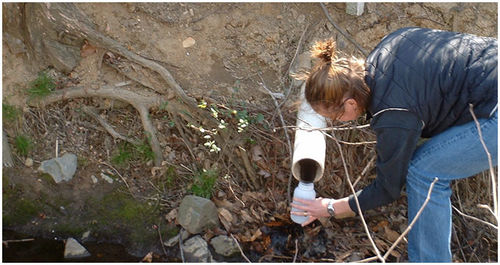
Difference between revisions of "MCM 3 Illicit Discharge Detection and Elimination"
| Line 7: | Line 7: | ||
:*A map of the MS4 that includes all pipes 12 inches or greater and their flow direction; outfalls, including the unique identifier and geographic coordinates; municipally owned or operated structural stormwater best management practices (BMPs); and all receiving waters. | :*A map of the MS4 that includes all pipes 12 inches or greater and their flow direction; outfalls, including the unique identifier and geographic coordinates; municipally owned or operated structural stormwater best management practices (BMPs); and all receiving waters. | ||
:*A [[#Model regulatory mechanisms|regulatory mechanism]] to prohibit illicit discharges. | :*A [[#Model regulatory mechanisms|regulatory mechanism]] to prohibit illicit discharges. | ||
| − | :*The incorporation of illicit discharge detection into all inspections and maintenance activities, such as those conducted on ponds, outfalls, and other structural stormwater BMPs. These inspections should be conducted during dry weather, when possible. | + | :*The incorporation of illicit discharge detection into all [[Municipal operation inspections|municipal operation inspection]] and maintenance activities, such as those conducted on ponds, outfalls, and other structural stormwater BMPs. These inspections should be conducted during dry weather, when possible. |
:*Detecting and tracking the source of illicit discharges using visual inspections. | :*Detecting and tracking the source of illicit discharges using visual inspections. | ||
| − | :*Training all field staff on illicit discharge recognition. | + | :*[[Employee training|Training]] of all field staff on illicit discharge recognition. |
:*Identifying priority areas likely to have illicit discharges by evaluating land uses associated with business and industrial activities, areas where illicit discharges have been observed in the past, areas with storage of large quantities of materials that could result in an illicit discharge. These locations should have additional illicit discharge inspections. | :*Identifying priority areas likely to have illicit discharges by evaluating land uses associated with business and industrial activities, areas where illicit discharges have been observed in the past, areas with storage of large quantities of materials that could result in an illicit discharge. These locations should have additional illicit discharge inspections. | ||
:*Procedures for investigating, locating, and eliminating the source of illicit discharges. | :*Procedures for investigating, locating, and eliminating the source of illicit discharges. | ||
Revision as of 20:10, 10 January 2018
Contents
Introduction
Our storm sewer systems carry water directly to our lakes, rivers, and wetlands without additional treatment, so to prevent pollution from entering our surface water, only clean stormwater should enter a storm sewer system. If any other discharge enters the system, it is usually an illicit discharge. Minimum Control Measure (MCM) 3 of the MS4 General Permit requires permittees to develop and implement a program to detect and eliminate illicit discharges within their storm sewer system.
Requirements
The illicit discharge detection and elimination (IDDE) program must include:
- A map of the MS4 that includes all pipes 12 inches or greater and their flow direction; outfalls, including the unique identifier and geographic coordinates; municipally owned or operated structural stormwater best management practices (BMPs); and all receiving waters.
- A regulatory mechanism to prohibit illicit discharges.
- The incorporation of illicit discharge detection into all municipal operation inspection and maintenance activities, such as those conducted on ponds, outfalls, and other structural stormwater BMPs. These inspections should be conducted during dry weather, when possible.
- Detecting and tracking the source of illicit discharges using visual inspections.
- Training of all field staff on illicit discharge recognition.
- Identifying priority areas likely to have illicit discharges by evaluating land uses associated with business and industrial activities, areas where illicit discharges have been observed in the past, areas with storage of large quantities of materials that could result in an illicit discharge. These locations should have additional illicit discharge inspections.
- Procedures for investigating, locating, and eliminating the source of illicit discharges.
- Spill response procedures. These procedures must include the requirement to notify the Minnesota Duty Officer.
- Enforcement Response Procedures to compel compliance with the illicit discharge prohibition regulatory mechanism.
- Documentation as required here.
Resources
Click on the blue links above in the "Requirements" section to get more information and resources specific to those permit requirements. In addition, all resources related to MCM 3 are below.
Fact sheets and guidance documents
- EPA MCM 3 guidance - EPA guidance and suggested BMPs for an effective illicit discharge detection and elimination program
- EPA Illicit Discharge Fact sheet - EPA fact sheet on MCM 3
- Illicit Discharge Detection and Elimination A Guidance Manual for Program Development and Technical Assessments - EPA's manual on techniques to detect and correct discharges in municipal storm drains
Model regulatory mechanisms
- Illicit Discharge Model Ordinance Language - EPA's model ordinance language for municipalities to prohibit illicit discharges and connections
Documentation and tracking templates
- Illicit Discharge documentation template - MPCA template to track the required information related to illicit discharges discovered or observed by municipal staff and reports (e.g. complaints, referrals) of illicit discharges received by the municipality.
- MS4 Illicit discharge discoveries and reports tracking template - MPCA template to track the required information related to illicit discharges discovered or observed by municipal staff and reports (e.g. complaints, referrals) of illicit discharges received by the municipality.
- Documentation that MS4 staff should retain - List of all the documentation requirements (what information to keep, how long to keep it, level of detail to keep, etc.) for compliance with the MS4 permit
- Enforcement action documentation template - MPCA's template for documenting all enforcement actions used to compel compliance with your regulatory mechanisms
- Employee training tracking template - MPCA template to document all required information related to employee training events
Checklists
Example procedures
Training tools
- Good Housekeeping employee training example - The City of Columbia Heights' employee training presentation
- Annual MS4 employee training example - City of Owatonna's employee training presentation
